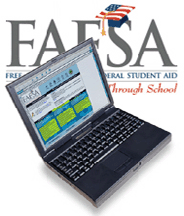Here’s a great post from the College Board in honor of Financial Aid Awareness month for parents, reminding all of us of the importance of the FAFSA and how to get ready for submission.
It’s time.
The Free Application for Federal Student Aid (FAFSA) is how millions of students apply for federal, state and most college-based financial aid. And because government grants compose 74 percent of this $185 billion pool, it’s understandable for families to feel anxious when filling out the FAFSA.
It doesn’t have to be that way. Susan McCrackin, Senior Director Financial Aid Methodology at the College Board, offers this eight-step map to help parents and students work through the FAFSA as efficiently and effectively as possible.
1. Gather Your Documents
It is much easier to fill out the FAFSA if you have all the needed forms in hand before you start. Here’s a list of documents to get you going. You should also get a U.S. Department of Education personal identification number (PIN.) Here’s the PIN application link.
2. Think About Taxes
Parents’ taxes are an important part in the FAFSA process. Getting taxes done by February 1st may be unrealistic, so last year’s taxes and this year’s paystubs can help create estimates. After February 3rd, the IRS Data Retrieval Tool becomes available, allowing students and parents to access the IRS tax return information needed to complete the FAFSA and transfer the data directly into their FAFSA from the IRS website. And if you owe the government money, take note: you can complete your taxes without actually filing and cutting a check to Uncle Sam.
3. Find Quiet Time
The FAFSA has a lot of sections. Breaking them into smaller pieces makes the FAFSA easier to navigate. Consider these do’s and don’ts.
- Don’t sprint. Take questions one at a time and give yourself time to properly answer each question.
- Do read each question carefully and out loud. It will help you understand the question better.
- Don’t multi-task. Put your mobile phone away, and turn off the television.
- Do find a quiet place where the FAFSA will have your full attention.
4. Stay Student Focused
Parents often forget that the student always provides information. Parents are required to provide their information if the student is dependent.
So when parents see a question that refers to “I,” remember that “I” is the student. “You” is also the student. When questions address parents, you will see questions that refer to “your parents.” This is where parental information goes.
5. Avoid Parent Traps
As families evolve, so do questions about who needs to provide information for the FAFSA. When you see “parents,” FAFSA is referring to the student’s biological or adoptive parents. When the parents are married, then the student and both parents complete the FAFSA.
If the parents are not together, things can get confusing. BigFuture by the College Board created a corresponding infographic to help address some commonly asked questions. That infographic will appear on this site tomorrow.
6. Keep Track of Deadlines
Every college has a different set of deadlines based on priority, merit, early decisions etc. BigFuture by the College Board helps families sort through these deadlines with detailed college profiles and a free, customized action plan. And, should you have specific questions about specific colleges or universities, don’t be afraid to call the college’s financial aid office and ask questions.
7. Profile CSS/Financial Aid PROFILE®
The FAFSA opens the doors to federal aid. There’s also almost $50 billion in non-federal aid available – from colleges, states and private institutions. Some colleges and programs use the College Board’s CSS/Financial Aid PROFILE to help award these monies.
CSS/Financial Aid PROFILE is an online application that collects information used by almost 400 colleges and scholarship programs to award financial aid outside sources from the federal government. Families must complete the application and the College Board sends it to the colleges and scholarship programs they have chosen.
Here’s a list of colleges that use CSS/Financial Aid PROFILE® and where you go to complete the CSS/Financial Aid PROFILE®. Sending your CSS/Financial Aid PROFILE® report to one college or scholarship program costs $25. Additional reports are $16 each. There are fee waivers available for low-income families.
8. Gain Experience
The more you experience something, the better you do. This free FAFSA webinar walks you section by section through an actual application with the College Board’s Senior Director for Financial Aid Methodology, Susan McCrackin. Families can access the free FAFSA webinar 24/7.
It’s time. Go after your piece of the more than $185 billion in financial aid to help make college possible. Use BigFuture for advice and to help create a customized plan for your child. Then follow the map. Chances are it will lead to an investment that provides returns for the rest of your child’s life.

